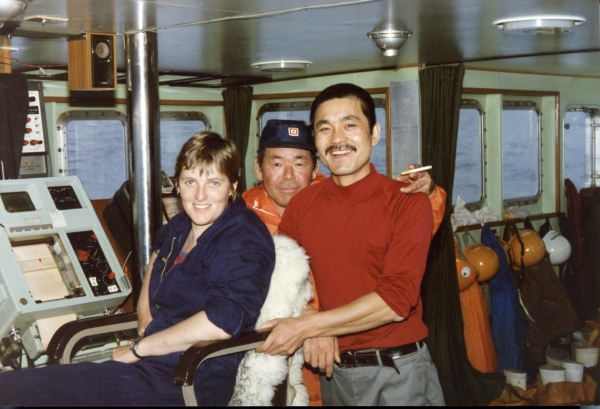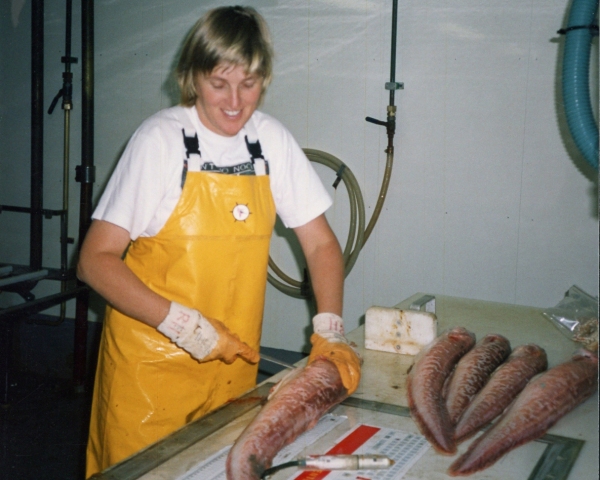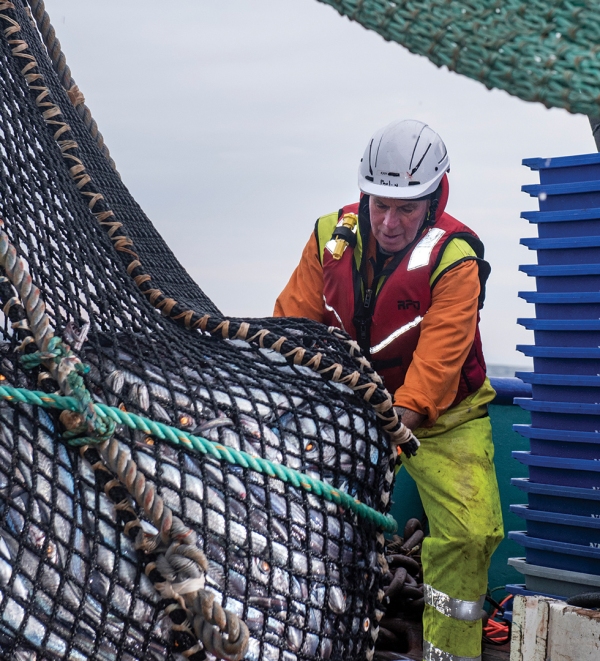The first time Dr Rosemary Hurst ate raw fish was on a Japanese commercial fishing boat hundreds of kilometres off the east coast of New Zealand.
Hurst was five years into her career as a deepwater fisheries scientist. Her previous experience with raw fish was picking parasitic worms out of fillets. That was for her PhD – this was dinner.
“I was a bit nervous about eating this raw fish. I picked it up with chopsticks and held it up to the light to check for worms before I ate it. I’d never eaten raw fish before and rapidly fell in love with it.”
Decades later, Hurst’s love for raw fish continues – as does her passion for fisheries science.
She is now NIWA’s Chief Scientist for Fisheries, having enjoyed a long and celebrated career delivering the research that underpins the management of New Zealand’s wild fisheries.
Hurst’s earliest memory of the sea was swimming in freezing waters off the south coast of England. Born and raised in London, she cherished family trips to the coast to visit her grandparents.
“I used to love walking up and down the beach finding little treasures. We didn’t have easy access to the sea like we do in New Zealand. It was a special treat.”
At nine years old, after occasional encounters with the ocean, Hurst found herself on it – literally. Trading the big smoke for the deep blue, her family packed their bags and spent six weeks aboard an ocean liner to start a new life in New Zealand. She’s lived here ever since.
Despite her affinity with the ocean, Hurst admits she never foresaw a career in fisheries.
“I started my PhD working in terrestrial ecology, but switched to working on the life cycle of marine parasites. I went out on research boats and I realised that I loved being at sea. It really got me hooked”.
Hurst hasn’t let go. Her science career charts the big changes in New Zealand’s fisheries over the past four decades and she was recently honoured with a NIWA Lifetime Achievement Award for her contribution to both fisheries science and the development of a sustainable industry.
“Science is fundamental to sustainable fisheries management,” says Hurst.
“It is essential for estimating potential yields and monitoring natural fluctuations and the impact of fishing over time.”
In 1978, New Zealand declared its Exclusive Economic Zone. With the stroke of a pen the country’s fisheries management responsibilities swept from the existing 12 nautical mile limit out to 200 nautical miles offshore.
At the time, New Zealand had virtually no vessels capable of harvesting deep water and a poor understanding of the fisheries themselves. The country was in serious need of fisheries expertise.
Hurst landed a job as a deepwater fisheries scientist with the Ministry of Agriculture and Fisheries, working on what was then New Zealand’s fifth largest and most valuable fishery – barracouta.
As her work evolved to include several other deepwater species, she began survey work on large offshore commercial vessels – often chartered by the New Zealand fishing industry from Russia or Japan.
“One Japanese commercial trawler was the Akebono Maru 73 – that was an amazing experience. The skipper had fished in New Zealand waters for about a decade and had invaluable experience from the early days of our deepwater fisheries.
“He had his own opinions about the stock size of some of our key species and was always willing to share his knowledge and learn more from us. His early estimate of the long-term sustainability of our hoki fishery, about 150,000 tonnes, has proved remarkably accurate.”
New Zealand’s Quota Management System (QMS)
New Zealand’s world leading Quota Management System (QMS) was introduced in 1986. Until then, fisheries were largely managed by restrictions on when, where and how fish could be taken. But from 1963 to 1973 the number of fishing boats in New Zealand more than doubled, sparking nationwide concern about overfishing.
The Government’s response was a catch control system to incentivise sustainable harvest.
The prospect of the new QMS and the promise it held for long-term fisheries management excited Hurst.
“I thought it had a lot of potential, so I was very keen to be involved.”
There were two key elements to the NZ QMS – the first major shift was putting a ceiling on the number of fish that could be taken by the commercial sector – the Total Allowable Commercial Catch (TACC).
The second was the introduction of Individual Transferable Quotas – a right to a proportion of the TACC for a particular species in a particular area.
To determine exactly how many fish could be taken under the QMS, fisheries scientists needed to determine how many fish were in New Zealand waters.
Hurst was involved in many of the exploratory surveys attempting to estimate fish abundance. Using research trawl findings, along with years of commercial fishing data, Hurst and her colleagues worked to establish early catch limits under the QMS.
“It was an exciting time because you really started to focus the research you were doing on what the management questions were.”
At 30 – just five years into her fisheries career – Hurst was travelling around New Zealand visiting fishing communities to help explain the science behind the big changes the QMS brought. It was not easy.
“When you’re sitting in a room with fishermen visibly upset by the fact their ability to catch fish is going to be cut in half … that was quite an eye opener for a young scientist. It really brought home the responsibility we had to get it right.”
Fisheries management is political. Communities, individuals and businesses all have their own interests and viewpoints, and balancing those while ensuring sustainable stocks is no easy task.
“There are no methods to work out the absolute biomass of fish.
“It’s not like counting sheep in a paddock, or trees in a forest – we’ve had to develop robust scientific systems for estimating fish populations.”
Hurst sees her work building the series of standardised trawl surveys covering inshore and middle-depth waters, now spanning nearly 30 years, as a career highlight. These focus on estimating the abundance and age structure of key commercial species as well as collecting data on all species landed.
“One of the things that I’ve always enjoyed about the science is that it’s directly relevant to management. You also get a lot of valuable feedback on what you’re doing through the MPI stock assessment working group process.”
She also acknowledges that, even with the trawl surveys and the latest advances in population modelling and acoustic monitoring techniques (see opposite page), estimating fish abundance is still challenging, and she continues to look for improvements.
Unexplained changes in some fish populations have led to the need to investigate other components of the ecosystem.
She references the declines in hoki catches in the early 2000s. While fishing pressure and low recruitment were contributing factors, there were potentially other things going on – like prey abundance, water temperature or current variations.
This variability will be better understood by taking a broader ecosystem approach.
RV Tangaroa’s recent voyage to the Southern Ocean is attempting to do just this. The science is focused on the effects of climate variability on ecosystem function in the Sub-Antarctic region, including effects on protected species and important fisheries, such as hoki.
Hurst says studies such as this, coupled with the time series of trawl surveys, can build on the QMS single-species approach to develop a wider ecosystem approach to management decisions.
“We now have the capability to take the next step, from Fishery Plans to Fishery Ecosystem Plans.
“Developing formal ecosystem plans would provide more visibility on where we are making progress and the priority areas we need to address.”
To illustrate her point, Hurst and colleagues are currently developing a multi-species online fish portal. The portal visualises 27 years of NIWA trawl survey data on the Chatham Rise across more than 30 species. It already enables users to easily compare trends in species abundance, and a further suite of ecosystem indicators is on the way.
“It’s made all the data more accessible, so that you can look to join the dots to ask important questions and develop hypotheses on what might be causing changes.”
Asked if New Zealanders can be proud of the big changes in our fisheries management regime over the past 30 years, Hurst doesn’t hesitate.
“Yes – getting key target species catch under control is the definitely the first important step to sustainable fisheries and ecosystem management, and the QMS has achieved this. Many of the adverse effects of fishing are also being monitored and managed.
“But extending this success to a system that more explicitly incorporates both fishery and broader ecosystem objectives – that will take our fisheries management to the next level.”
This article forms part of Water & Atmosphere 23, read more stories from this series.




